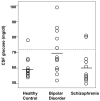Elevated cerebrospinal fluid lactate concentrations in patients with bipolar disorder and schizophrenia: implications for the mitochondrial dysfunction hypothesis
- PMID: 19103439
- PMCID: PMC3752997
- DOI: 10.1016/j.biopsych.2008.11.010
Elevated cerebrospinal fluid lactate concentrations in patients with bipolar disorder and schizophrenia: implications for the mitochondrial dysfunction hypothesis
Abstract
Background: Evidence is accumulating that mitochondrial dysfunction is involved in the pathophysiology of bipolar disorder and schizophrenia. Cerebrospinal fluid (CSF) concentration of lactate, a product of extra-mitochondrial glucose metabolism, is commonly elevated in individuals with mitochondrial disorders, especially those with neuropsychiatric symptoms. We tested the hypothesis that patients with bipolar disorder and schizophrenia would, on average, have elevated CSF lactate concentrations compared with healthy control subjects.
Methods: The CSF lactate and CSF and plasma glucose concentrations were measured with a YSI (YSI, Yellow Springs, Ohio) 2300 STAT Plus Glucose & Lactate Analyzer in 15 samples from each of three groups of subjects: bipolar I disorder patients, schizophrenic patients, and healthy control subjects.
Results: Mean CSF lactate concentrations were significantly higher in bipolar (1.76 +/- .38) and schizophrenic subjects (1.61 +/- .31) compared with control subjects (1.31 +/- .21 mmol/L). These differences persisted after adjusting means for CSF glucose concentration, which correlated positively with CSF lactate concentration.
Conclusions: This is the first report of increased CSF lactate concentrations in patients with bipolar disorder and schizophrenia. Elevated CSF lactate indicates increased extra-mitochondrial and anaerobic glucose metabolism and is consistent with impaired mitochondrial metabolism. Measuring CSF lactate concentration might help identify bipolar and schizophrenic patients with mitochondrial dysfunction who might benefit from research to elucidate and ultimately rectify possible mitochondrial pathology underlying these disorders.
Conflict of interest statement
The authors report no biomedical financial interests or potential conflicts of interest.
Figures



References
-
- Kato T, Kato N. Mitochondrial dysfunction in bipolar disorder. Bipolar Disord. 2000;2:180–190. - PubMed
-
- Quiroz JA, Gray NA, Kato T, Manji HK. Mitochondrially mediated plasticity in the pathophysiology and treatment of bipolar disorder. Neuropsychopharmacology. 2008;33:2551–2565. - PubMed
-
- Stork C, Renshaw PF. Mitochondrial dysfunction in bipolar disorder: Evidence from magnetic resonance spectroscopy research. Mol Psychiatry. 2005;10:900–919. - PubMed
-
- Kung L, Roberts RC. Mitochondrial pathology in human schizophrenic striatum: A postmortem ultrastructural study. Synapse. 1999;31:67–75. - PubMed
Publication types
MeSH terms
Substances
Grants and funding
LinkOut - more resources
Full Text Sources
Other Literature Sources
Medical

